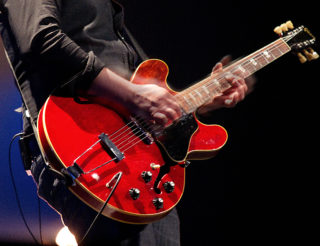How (And Why) You Should Be Using A Guitar Chord Identifier Tool
Author: Matthew King

Guitar music theory is a messy, frightening void that sends many guitar players into utter fear. Thankfully, there’s now an app for that!
A chord identifier tool is what helped me unlock much of the fretboard so I could make not only make chord progressions, but also figure out how the music of my favorite artists worked. At first I wanted to be a great lead guitarist, and I loved the game of figuring out what scale or chord tones a guitarist used and why.
Like our chord identifier tool that we’ll be referencing throughout this article, guitar music theory is also a tool to use to make yourself a better, more knowledgeable player. Once you understand how intervals and chords influence the music you love and play……you’re not going to be able to get enough of this!
Let’s take you through some of the first discoveries I made when venturing into the world of music theory……
Table of Contents
Step 1: Learn Your Basic Scales
You may already know some basic scales, but more than likely you don’t see how closely they’re related. Trust me that this is the most important step to take before learning chords for most of you…..
So go and use any scale finder of your choosing online to search for the following scales in this order only:
- E minor pentatonic
- E minor scale
- G major scale
- G major pentatonic
They are all basically the same scale! They just start on different notes, or they have either 5 or 7 notes in them. Believe it or not, lots of scales and modes can be simplified like this!
<script>!function(e,r,d){var t,c=e.getElementsByTagName(r)[0];e.getElementById(d)||(t=e.createElement(r),t.id=d,t.src=”https://uberchord-backend.firebaseapp.com/uberchord-embed-sdk.js”,c.parentNode.insertBefore(t,c))}(document,”script”,”uberchord-jssdk”);</script>
<div data-autosize=”1″ data-no-icon=”1″ class=”uberchord-chords” data-search-by=”names” data-search-query=”E_m_,G__”></div>
When you take the next step, and learn more about scale/chord theory, you’ll be surprised how much music can be broken down once you know the ins and outs of these four crucial scales.
Step 2: Learn The Notes Behind Your Basic Chords
Now, using our chord identifier tool, look up the notes behind these 4 chords:
- Em
- G
- C
- D
<script>!function(e,r,d){var t,c=e.getElementsByTagName(r)[0];e.getElementById(d)||(t=e.createElement(r),t.id=d,t.src=”https://uberchord-backend.firebaseapp.com/uberchord-embed-sdk.js”,c.parentNode.insertBefore(t,c))}(document,”script”,”uberchord-jssdk”);</script>
<div data-autosize=”1″ data-no-icon=”1″ class=”uberchord-chords” data-search-by=”names” data-search-query=”E_m_,G__,C__,D__”></div>
All of these notes come from the scale/key of E minor! Now, we’d have to spend some time breaking down the notes behind the scales and chords to tell you why that is. However, this should tell you so much now about why certain chords go well with certain scales!
If you’re looking for an easy way to start remembering and looking up chords, then please go check out our chord identifier tool.
Step 3: Explore The Chord/Scale Relationship
The next step is going to help you see exactly how chords and scales are related to each other, and, in some ways, are kind of the same thing. So follow these steps:
- Pull up the A minor pentatonic scale, then pull up the Am7 chord or arpeggios using the Uberchord chord identifier
- Do the same thing with the C major scale and then the C chord
- Now do that with the G mixolydian mode with G7
- And finally do that with the Dm7 arpeggios or chord shapes with the D Dorian mode
<script>!function(e,r,d){var t,c=e.getElementsByTagName(r)[0];e.getElementById(d)||(t=e.createElement(r),t.id=d,t.src=”https://uberchord-backend.firebaseapp.com/uberchord-embed-sdk.js”,c.parentNode.insertBefore(t,c))}(document,”script”,”uberchord-jssdk”);</script>
<div data-autosize=”1″ class=”uberchord-chords” data-search-by=”names” data-search-query=”A_m7_,C__,G_7_,Dm7__”></div>
Hopefully you’ve seen that all the chord tones and shapes align perfectly with the scale patterns you just pulled up!
Step 4: Choose Which Scales To Use With A Chord
Because a chord is usually just made up of 2-3 notes, and a scale is made up of 5-7 notes…..you may have noticed that you have many more scale choices than you may think!
Just go back to the scales and chords you pulled up in Step 3. D dorian has the notes of G7. C major has the notes of Am7. A minor pentatonic has the same notes as the C chord.
Almost any scale that contains the notes of the chord you’re playing over can work! It may not always be the best choice, but then again music is subjective.
Step 5: Next Steps To Exploring The Chord/Scale Finder
The final step is the one that’s the most fun. Just do the three following things:
- Take some of your favorite songs and break down the chords in the key of that song.
- Identify the scales used in your favorite solos and input the scales, as well as the chord changes underneath the solo.
- Explore new chord possibilities and practice using new scales.
Music is not only an art and a science, but a fun activity too. To us here at Uberchord, it’s a lot of fun to use the concepts of music theory to figure out what our favorite players and songwriters are doing to create the music we love. That’s the beauty behind our chord identifier! It holds the secrets to a lot of music you want to learn from…..if you choose to put it to good use.








No comments yet - be the first.